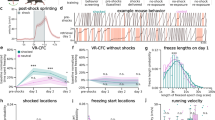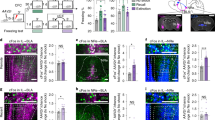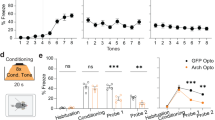Abstract
Decades of research support the idea that associations between a conditioned stimulus (CS) and an unconditioned stimulus (US) are encoded in the lateral amygdala (LA) during fear learning. However, direct proof for the sources of CS and US information is lacking. Definitive evidence of the LA as the primary site for cue association is also missing. Here, we show that calretinin (Calr)-expressing neurons of the lateral thalamus (Calr+LT neurons) convey the association of fast CS (tone) and US (foot shock) signals upstream from the LA in mice. Calr+LT input shapes a short-latency sensory-evoked activation pattern of the amygdala via both feedforward excitation and inhibition. Optogenetic silencing of Calr+LT input to the LA prevents auditory fear conditioning. Notably, fear conditioning drives plasticity in Calr+LT neurons, which is required for appropriate cue and contextual fear memory retrieval. Collectively, our results demonstrate that Calr+LT neurons provide integrated CS–US representations to the LA that support the formation of aversive memories.
This is a preview of subscription content, access via your institution
Access options
Access Nature and 54 other Nature Portfolio journals
Get Nature+, our best-value online-access subscription
$29.99 / 30 days
cancel any time
Subscribe to this journal
Receive 12 print issues and online access
$209.00 per year
only $17.42 per issue
Buy this article
- Purchase on Springer Link
- Instant access to full article PDF
Prices may be subject to local taxes which are calculated during checkout








Similar content being viewed by others
Data availability
Data from this study as well as material from custom products are available from the corresponding author upon request.
Code availability
Custom-written codes used to analyze data from this study are available from the corresponding author upon request.
References
LeDoux, J. E. Emotion, memory and the brain. Sci. Am. 270, 50–57 (1994).
Blair, H. T., Schafe, G. E., Bauer, E. P., Rodrigues, S. M. & LeDoux, J. E. Synaptic plasticity in the lateral amygdala: a cellular hypothesis of fear conditioning. Learn. Mem. 8, 229–242 (2001).
Pape, H.-C. & Pare, D. Plastic synaptic networks of the amygdala for the acquisition, expression, and extinction of conditioned fear. Physiol. Rev. 90, 419–463 (2010).
Nabavi, S. et al. Engineering a memory with LTD and LTP. Nature 511, 348–352 (2014).
Weinberger, N. M. The medial geniculate, not the amygdala, as the root of auditory fear conditioning. Hear. Res. 274, 61–74 (2011).
Headley, D. B., Kanta, V., Kyriazi, P. & Paré, D. Embracing complexity in defensive networks. Neuron 103, 189–201 (2019).
Quirk, G. J., Repa, C. & LeDoux, J. E. Fear conditioning enhances short-latency auditory responses of lateral amygdala neurons: parallel recordings in the freely behaving rat. Neuron 15, 1029–1039 (1995).
LeDoux, J. E., Farb, C. & Ruggiero, D. A. Topographic organization of neurons in the acoustic thalamus that project to the amygdala. J. Neurosci. 10, 1043–1054 (1990).
LeDoux, J. E., Sakaguchi, A. & Reis, D. J. Subcortical efferent projections of the medial geniculate nucleus mediate emotional responses conditioned to acoustic stimuli. J. Neurosci. 4, 683–698 (1984).
Campeau, S. & Davis, M. Involvement of subcortical and cortical afferents to the lateral nucleus of the amygdala in fear conditioning measured with fear-potentiated startle in rats trained concurrently with auditory and visual conditioned stimuli. J. Neurosci. 15, 2312–2327 (1995).
Lanuza, E., Nader, K. & LeDoux, J. E. Unconditioned stimulus pathways to the amygdala: effects of posterior thalamic and cortical lesions on fear conditioning. Neuroscience 125, 305–315 (2004).
Han, S., Soleiman, M. T., Soden, M. E., Zweifel, L. S. & Palmiter, R. D. Elucidating an affective pain circuit that creates a threat memory. Cell 162, 363–374 (2015).
Johansen, J. P., Tarpley, J. W., LeDoux, J. E. & Blair, H. T. Neural substrates for expectation-modulated fear learning in the amygdala and periaqueductal gray. Nat. Neurosci. 13, 979–986 (2010).
Kim, E. J. et al. Dorsal periaqueductal gray–amygdala pathway conveys both innate and learned fear responses in rats. Proc. Natl Acad. Sci. USA 110, 14795–14800 (2013).
Penzo, M. A. et al. The paraventricular thalamus controls a central amygdala fear circuit. Nature 519, 455–459 (2015).
Do-Monte, F. H., Quiñones-Laracuente, K. & Quirk, G. J. A temporal shift in the circuits mediating retrieval of fear memory. Nature 519, 460–463 (2015).
Mátyás, F. et al. A highly collateralized thalamic cell type with arousal-predicting activity serves as a key hub for graded state transitions in the forebrain. Nat. Neurosci. 21, 1551–1562 (2018).
Zhu, Y. et al. Dynamic salience processing in paraventricular thalamus gates associative learning. Science 362, 423–429 (2018).
Bordi, F. & LeDoux, J. E. Response properties of single units in areas of rat auditory thalamus that project to the amygdala. II. Cells receiving convergent auditory and somatosensory inputs and cells antidromically activated by amygdala stimulation. Exp. Brain Res. 98, 275–286 (1994).
Lanuza, E., Moncho-Bogani, J. & LeDoux, J. E. Unconditioned stimulus pathways to the amygdala: effects of lesions of the posterior intralaminar thalamus on foot-shock-induced c-Fos expression in the subdivisions of the lateral amygdala. Neuroscience 155, 959–968 (2008).
Han, J.-H. et al. Increasing CREB in the auditory thalamus enhances memory and generalization of auditory conditioned fear. Learn. Mem. 15, 443–453 (2008).
LeDoux, J. E., Ruggiero, D. A., Forest, R., Stornetta, R. & Reis, D. J. Topographic organization of convergent projections to the thalamus from the inferior colliculus and spinal cord in the rat. J. Comp. Neurol. 264, 123–146 (1987).
Linke, R., De Lima, A. D., Schwegler, H. & Pape, H. C. Direct synaptic connections of axons from superior colliculus with identified thalamo-amygdaloid projection neurons in the rat: possible substrates of a subcortical visual pathway to the amygdala. J. Comp. Neurol. 403, 158–170 (1999).
Coleman, J. R. & Clerici, W. J. Sources of projections to subdivisions of the inferior colliculus in the rat. J. Comp. Neurol. 262, 215–226 (1987).
King, A. J. The superior colliculus. Curr. Biol. 14, R335–R338 (2004).
Hayashi, H., Sumino, R. & Sessle, B. J. Functional organization of trigeminal subnucleus interpolaris: nociceptive and innocuous afferent inputs, projections to thalamus, cerebellum, and spinal cord, and descending modulation from periaqueductal gray. J. Neurophysiol. 51, 890–905 (1984).
Bartlett, E. L., Stark, J. M., Guillery, R. W. & Smith, P. H. Comparison of the fine structure of cortical and collicular terminals in the rat medial geniculate body. Neuroscience 100, 811–828 (2000).
Busti, D. et al. Different fear states engage distinct networks within the intercalated cell clusters of the amygdala. J. Neurosci. 31, 5131–5144 (2011).
Grewe, B. F. et al. Neural ensemble dynamics underlying a long-term associative memory. Nature 543, 670–675 (2017).
Asede, D., Bosch, D., Lüthi, A., Ferraguti, F. & Ehrlich, I. Sensory inputs to intercalated cells provide fear-learning modulated inhibition to the basolateral amygdala. Neuron 86, 541–554 (2015).
Wolff, S. B. E. et al. Amygdala interneuron subtypes control fear learning through disinhibition. Nature 509, 453–458 (2014).
Woodson, W., Farb, C. R. & LeDoux, J. E. Afferents from the auditory thalamus synapse on inhibitory interneurons in the lateral nucleus of the amygdala. Synapse 38, 124–137 (2000).
Krabbe, S. et al. Adaptive disinhibitory gating by VIP interneurons permits associative learning. Nat. Neurosci. 22, 1834–1843 (2019).
Almeida, T. F., Roizenblatt, S. & Tufik, S. Afferent pain pathways: a neuroanatomical review. Brain Res. 1000, 40–56 (2004).
Cho, J.-H., Rendall, S. D. & Gray, J. M. Brain-wide maps of Fos expression during fear learning and recall. Learn. Mem. 24, 169–181 (2017).
Sacco, T. & Sacchetti, B. Role of secondary sensory cortices in emotional memory storage and retrieval in rats. Science 329, 649–656 (2010).
Zelikowsky, M., Bissiere, S. & Fanselow, M. S. Contextual fear memories formed in the absence of the dorsal hippocampus decay across time. J. Neurosci. 32, 3393–3397 (2012).
Morris, J. S., Ohman, A. & Dolan, R. J. A subcortical pathway to the right amygdala mediating “unseen” fear. Proc. Natl Acad. Sci. USA. 96, 1680–1685 (1999).
Rafal, R. D. et al. Connectivity between the superior colliculus and the amygdala in humans and macaque monkeys: virtual dissection with probabilistic DTI tractography. J. Neurophysiol. 114, 1947–1962 (2015).
Zhou, N., Maire, P. S., Masterson, S. P. & Bickford, M. E. The mouse pulvinar nucleus: organization of the tectorecipient zones. Vis. Neurosci. 34, E011 (2017).
Harris, J. A. et al. Hierarchical organization of cortical and thalamic connectivity. Nature 575, 195–202 (2019).
Letzkus, J. J. et al. A disinhibitory microcircuit for associative fear learning in the auditory cortex. Nature 480, 331–335 (2011).
Courtin, J., Karalis, N., Gonzalez-Campo, C., Wurtz, H. & Herry, C. Persistence of amygdala gamma oscillations during extinction learning predicts spontaneous fear recovery. Neurobiol. Learn. Mem. 113, 82–89 (2014).
Amir, A., Headley, D. B., Lee, S.-C., Haufler, D. & Paré, D. Vigilance-associated gamma oscillations coordinate the ensemble activity of basolateral amygdala neurons. Neuron 97, 656–669.e7 (2018).
Li, X. F., Stutzmann, G. E. & LeDoux, J. E. Convergent but temporally separated inputs to lateral amygdala neurons from the auditory thalamus and auditory cortex use different postsynaptic receptors: in vivo intracellular and extracellular recordings in fear conditioning pathways. Learn. Mem. 3, 229–242 (1996).
Johnson, L. R. Hebbian reverberations in emotional memory micro circuits. Front. Neurosci. 3, 198–205 (2009).
Weisskopf, M. G. & LeDoux, J. E. Distinct populations of NMDA receptors at subcortical and cortical inputs to principal cells of the lateral amygdala. J. Neurophysiol. 81, 930–934 (1999).
Tye, K. M., Stuber, G. D., de Ridder, B., Bonci, A. & Janak, P. H. Rapid strengthening of thalamo-amygdala synapses mediates cue–reward learning. Nature 453, 1253–1257 (2008).
Rich, M. T., Huang, Y. H. & Torregrossa, M. M. Plasticity at thalamo-amygdala synapses regulates cocaine-cue memory formation and extinction. Cell Rep. 26, 1010–1020.e5 (2019).
Likhtik, E. & Johansen, J. P. Neuromodulation in circuits of aversive emotional learning. Nat. Neurosci. 22, 1586–1597 (2019).
Kim, S., Matyas, F., Lee, S., Acsady, L. & Shin, H.-S. Lateralization of observational fear learning at the cortical but not thalamic level in mice. Proc. Natl Acad. Sci. USA 109, 15497–15501 (2012).
Mátyás, F., Lee, J., Shin, H.-S. & Acsády, L. The fear circuit of the mouse forebrain: connections between the mediodorsal thalamus, frontal cortices and basolateral amygdala. Eur. J. Neurosci. 39, 1810–1823 (2014).
Cai, D. et al. Distinct anatomical connectivity patterns differentiate subdivisions of the nonlemniscal auditory thalamus in mice. Cereb. Cortex 29, 2437–2454 (2018).
Paxinos, G. & Franklin, K. B. J. The Mouse Brain in Stereotaxic Coordinates (Academic Press, 2003).
Quirk, G. J., Armony, J. L. & LeDoux, J. E. Fear conditioning enhances different temporal components of tone-evoked spike trains in auditory cortex and lateral amygdala. Neuron 19, 613–624 (1997).
Gauriau, C. & Bernard, J.-F. A comparative reappraisal of projections from the superficial laminae of the dorsal horn in the rat: the forebrain. J. Comp. Neurol. 468, 24–56 (2004).
Lipshetz, B. et al. Responses of thalamic neurons to itch- and pain-producing stimuli in rats. J. Neurophysiol. 120, 1119–1134 (2018).
Swanson, L. W. Brain Maps: Structure of the Rat Brain (Elsevier Academic Press, 2004).
Szőnyi, A. et al. Brainstem nucleus incertus controls contextual memory formation. Science 364, eaaw0445 (2019).
Wickersham, I. R. et al. Monosynaptic restriction of transsynaptic tracing from single, genetically targeted neurons. Neuron 53, 639–647 (2007).
Mahn, M., Prigge, M., Ron, S., Levy, R. & Yizhar, O. Biophysical constraints of optogenetic inhibition at presynaptic terminals. Nat. Neurosci. 19, 554–556 (2016).
Rossant, C. et al. Spike sorting for large, dense electrode arrays. Nat. Neurosci. 19, 634–641 (2016).
Meredith, M. A. & Stein, B. E. Visual, auditory, and somatosensory convergence on cells in superior colliculus results in multisensory integration. J. Neurophysiol. 56, 640–662 (1986).
Barthó, P. et al. Characterization of neocortical principal cells and interneurons by network interactions and extracellular features. J. Neurophysiol. 92, 600–608 (2004).
Mikics, É., Barsy, B., Barsvári, B. & Haller, J. Behavioral specificity of non-genomic glucocorticoid effects in rats: effects on risk assessment in the elevated plus-maze and the open-field. Horm. Behav. 48, 152–162 (2005).
Walf, A. A. & Frye, C. A. The use of the elevated plus maze as an assay of anxiety-related behavior in rodents. Nat. Protoc. 2, 322–328 (2007).
Rodgers, R. J., Cao, B.-J., Dalvi, A. & Holmes, A. Animal models of anxiety: an ethological perspective. Braz. J. Med. Biol. Res. 30, 289–304 (1997).
Acknowledgements
We thank Z. J. Huang, L. Acsády and S. Arthaud for providing us with transgenic mice, C. Porrero and F. Clascá for their instructions for BDA injections, N. Holderith for sharing primary antibodies, Cs. Dávid for advising us on axonal analysis and A. Szőnyi for rabies injections. The technical assistance of K. Varga, V. Kanti, J. Berczik, A. Fehér, L. Truka, R. Pop and E. Szabó-Együd in histology is acknowledged. We wish to thank the Institute of Enzymology at RCNS, Nikon Microscopy Center at IEM, Nikon Austria and the Auro-Science Consulting for kindly providing microscopy, as well as the Institute of Materials and Environmental Chemistry at RCNS for technical support. We thank L. Acsády, N. Bunford, T. L. Horváth, M. Penzo and I. Soltész for comments and discussions about the manuscript. This work was supported by the National Office for Research and Technology (FK124434 and KKP126998 to F.M., PD124034 to B.B., and FK129120 to D.H.), by the Hungarian Brain Research Program (grant numbers KTIA-NAP-13-2-2015-0010 to F.M., and 2017-1.2.1-NKP-2017-00002 to F.M. and I.U.), by the New National Excellence Program of the Ministry for Innovation and Technology (ÚNKP-19-3-III-PPKE-68 to K.K., and ÚNKP-19-4-ÁTE-8 to F.M.), by the Széchenyi 2020 Program, the Human Resource Development Operational Program, the Program of Integrated Territorial Investments in Central-Hungary (EFOP-3.6.2-16-2017-00013 and 3.6.3-VEKOP-16-2017-00002 to K.K. and I.U.; EFOP-3.6.2-16-2017-00012 to F.M.), by the Adelis Foundation (O.Y.), and by the European Research Council (ERC CoG 819496 to O.Y.). F.M. is a János Bolyai Research Fellow.
Author information
Authors and Affiliations
Contributions
B.B., K.K., I.U. and F.M. designed the experiments. B.B., K.K., Á.B., A.M., J.M.V. and F.M. performed animal surgeries, immunocytochemistry and confocal analyses. B.B. and M.S. conducted behavioral experiments and analyses. K.K. and A.M. performed in vivo electrophysiological recordings and data analyses. O.Y. developed the AAV-DFO plasmid, and D.H. produced the AAV-DFO viral vector. B.B., K.K. and F.M. wrote the manuscript, which was edited by all authors.
Corresponding author
Ethics declarations
Competing interests
The authors declare no competing interests.
Additional information
Peer review information Nature Neuroscience thanks Fabricio H. do Monte and the other, anonymous, reviewer(s) for their contribution to the peer review of this work.
Publisher’s note Springer Nature remains neutral with regard to jurisdictional claims in published maps and institutional affiliations.
Supplementary information
Supplementary Information
Supplementary Figs. 1–10 and Supplementary Tables 1–7.
Supplementary Video 1
Green-light illumination of Calr+LT→AMG axons during fear conditioning (for the entire period of the 30 s of CS+) diminishes freezing behavior in a representative NpHR animal (right; n = 7 mice in total) compared with a representative control (YFP, left; n = 6 mice in total). The video shows behavioral responses to the seventh CS+US presentation. Related to Fig. 6d.
Supplementary Video 2
Behavioral responses evoked by the second CS+ presentation during cued fear retrieval observed in the same two animals shown in Supplementary Video 1. Related to Fig. 6e.
Rights and permissions
About this article
Cite this article
Barsy, B., Kocsis, K., Magyar, A. et al. Associative and plastic thalamic signaling to the lateral amygdala controls fear behavior. Nat Neurosci 23, 625–637 (2020). https://doi.org/10.1038/s41593-020-0620-z
Received:
Accepted:
Published:
Issue Date:
DOI: https://doi.org/10.1038/s41593-020-0620-z
This article is cited by
-
Recombinase-independent AAV for anterograde transsynaptic tracing
Molecular Brain (2023)
-
Region-selective control of the thalamic reticular nucleus via cortical layer 5 pyramidal cells
Nature Neuroscience (2023)
-
Revealing the Precise Role of Calretinin Neurons in Epilepsy: We Are on the Way
Neuroscience Bulletin (2022)
-
Single cell plasticity and population coding stability in auditory thalamus upon associative learning
Nature Communications (2021)
-
Subcortical circuits mediate communication between primary sensory cortical areas in mice
Nature Communications (2021)



